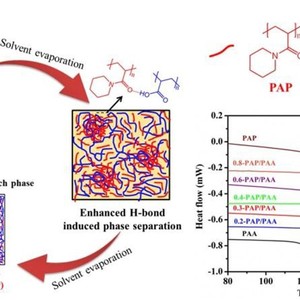Hydrogen Bond Mediated Partially Miscible Poly(N-Acryloyl Piperidine)/Poly(Acrylic Acid) Blend...
Citation
Xiongwei Wang, Yunfeng Yang, Yuanyuan Zhou, Peiyi Wu*, Hongyu Chen, and Peter Trefonas. Hydrogen Bond Mediated Partially Miscible Poly(N-Acryloyl Piperidine)/Poly(Acrylic Acid) Blend with One Glass Transition Temperature. Polymer 2018, 151, 269-278.
Abstract
In this work, we have systematically studied the miscibility and phase structure of a hydrogen-bonded polymer blend composed of short rigid poly(N-acryloyl piperidine) (PAP) and long flexible poly(acrylic acid) (PAA). Ultrathin PAP/PAA blend films with various compositions were prepared by solution-casting method. It was found that the spin-coated blend films had distinct surface features with many protuberant domains that can be extracted by toluene. Composition analysis of the isolated protrusion domains and matrix domains revealed that PAP/PAA blend is a partially miscible system with PAP-rich protrusion phase (dispersed phase) and PAA-rich matrix phase. The hydrogen-bonding interaction between the amide carbonyl of PAP and hydroxyl of PAA (O=C⋯H-O) was found to account for the partial miscibility of these two components. Interestingly, only one positively shifted glass transition temperature (Tg) was detected for this blend. This behavior is very different from other reported partially miscible polymer blends, in which two inward shifted Tgs are usually observed. Thermal analysis further disclosed that Tgs of PAP-rich dispersed phase and PAA-rich matrix phase are very close to each other, thus merged into one broad Tgpresented in the blend. The close Tgs of these two phases is attributed to the strong hydrogen-bonding interaction between PAP and PAA, which surpasses the compositional difference between them. At high PAP concentrations (above 60 mol percent), the separation of excess PAP in dispersed phase contributed to the appearance of a second Tg that corresponds to that of PAP. Such phase behavior was further confirmed in the free-standing films of PAP/PAA blends.


